Diffusiophoresis and electrokinetic transport phenomenaA major focus of our research involves the study of nonlinear, highly coupled, multi-physics transport phenomena involving interactions between solutes, fluids, and suspended particles in non-equilibrium environments. In such conditions, spontaneous transport phenomena such as diffusiophoresis can induce surprising particle/fluid/solute dynamics that can facilitate the design of novel systems for particle manipulation applications such as sorting, filtration, detection, and others. We seek to understand such coupled systems with a view for biomedical and industrial applications.
Several of the specific projects we have pursued include developing novel techniques for characterizing surface-solute interactions via diffusioosmosis as well as measuring the zeta potential of surfaces and/or particles via particle tracking in micro-scale pores. We have also systematically analyzed the coupled transport dynamics in narrow channel flows and demonstrated the rapid accumulation of particles in flow junctions via the competition between fluid flow and diffusiophoresis. | 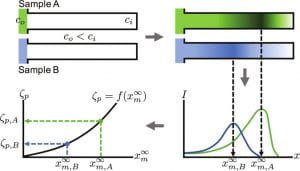
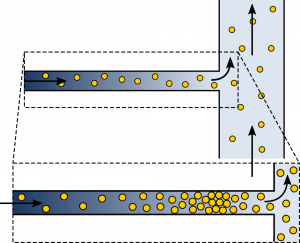 |
Papers:
- J. T. Ault, S. Shin, and H. A. Stone. Characterization of surface-solute interactions by diffusioosmosis. Soft Matter, 15(7):1582-1596, 2019
- J. T. Ault, S. Shin, and H. A. Stone. Diffusiophoresis in narrow channel flows. J. Fluid Mech., 854:420-448, Sept. 2018
- S. Shin, J. T. Ault, P. B. Warren, and H. A. Stone. Accumulation of colloidal particles in flow junctions induced by fluid flow and diffusiophoresis. Phys. Rev. X, 7(4), Nov. 2017
- S. Shin, J. T. Ault, J. Feng, P. B. Warren, and H. A. Stone. Low-cost zeta potentiometry using solute gradients. Adv. Mater., 29(30):1701516, June 2017
|
Vortex dynamics in branching and bending flowsWe use experiments and numerical simulations to study the nonlinear vortex breakdown phenomenon. We recently discovered recirculation zones in simple branching junctions that have all the classical signatures of vortex breakdown. Using simulations, we study how these features originate and evolve as flow properties change.
We also use experiments to study how these vortex breakdown recirculation zones interact with bubbles and particles in multi-phase flows. We especially study the effects of geometry on the dynamical flow features and how flow conditions can be used to maximize or eliminate particle/bubble capture in these zones (see video at the right). We are also interested in the practical applications of this new capture mechanism and recently demonstrated a shear-induced rapid technique for producing large lipid vesicles using this vortex trapping. | 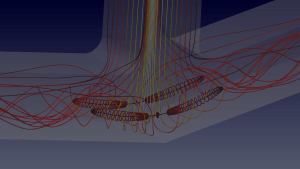
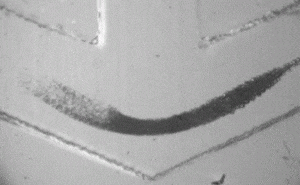
|
Papers:
- S. T. Chan* , J. T. Ault* , S. J. Haward, E. Meiburg, and A. Q. Shen. Coupling of vortex breakdown and stability in a swirling flow. Phys. Rev. Fluids, 4(8):084701, 2019. *The authors contributed equally to this work
- *D. Oettinger, J. T. Ault, H. A. Stone, and G. Haller. Invisible anchors trap particles in branching junctions. Phys. Rev. Lett., 121(5):054502, Aug. 2018. *Featured as Editor’s Suggestion.
- J. T. Ault, A. Fani, K. K. Chen, S. Shin, F. Gallaire, and H. A. Stone. Vortex-breakdown-induced particle capture in branching junctions. Phys. Rev. Lett., 117(8), Aug. 2016
- S. Shin* , J. T. Ault* , and H. A. Stone. Flow-driven rapid vesicle fusion via vortex trapping. Langmuir, 31(26):7178–7182, June 2015. *The authors contributed equally to this work
|
Classical fluid dynamics in pipe flowsPart of our research involves the theoretical modeling and simulation of developing flows in the entrance and exit regions of a curved pipe. In particular, we developed asymptotic analytical solutions for the developing flow in a curved pipe and for the transitioning flow downstream of a curved pipe. More recently, we developed analytical solutions that govern the spatial decay of any general 3D pipe flow perturbation.
| 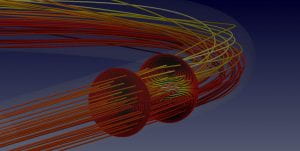 |
Papers:
- J. T. Ault, B. Rallabandi, O. Shardt, K. K. Chen, and H. A. Stone. Entry and exit flows in curved pipes. J. Fluid Mech., 815:570-591, Feb. 2017
- J. T. Ault, K. K. Chen, and H. A. Stone. Downstream decay of fully developed Dean flow. J. Fluid Mech., 777:219–244, July 2015
|
Diffusiophoretic particle motions in dead-end poresOur research also involves the study and simulation of complex flows experiencing multiple simultaneous transport processes occurring over a wide range of scales, such as the diffusiophoretic motion of particles in dead-end pores exposed to non-equilibrium concentration gradients. Recently we used experiments and simulations to show that the penetration of particles into dead-end pores can be driven and controlled using solute gradients, and we systematically characterized these dynamics. | 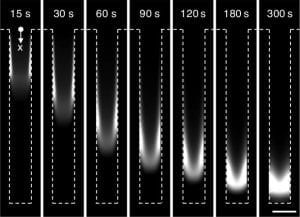 |
Papers:
- S. Battat, J. T. Ault, S. Shin, S. Khodaparast, and H. A. Stone. Particle entrainment in dead-end pores by diffusiophoresis. Soft Matter, 15(19):3879–3885, 2019
- J. T. Ault, P. B. Warren, S. Shin, and H. A. Stone. Diffusiophoresis in one-dimensional solute gradients. Soft Matter, 13(47):9015-9023, Nov. 2017
- S. Shin, E. Um, B. Sabass, J. T. Ault, M. Rahimi, P. B. Warren, and H. A. Stone. Size-dependent control of colloid transport via solute gradients in dead-end channels. P. Natl. Acad. Sci. USA, 113(2):257-261, Dec. 2015
|
Evaporative cooling and water purification using thin-film flowsOne issue that we are especially passionate about is water scarcity. According to the World Health Organization, nearly 1 billion people do not have reliable access to safe drinking water. The water scarcity index reported by the United Nations Environment Programme shows that many millions of people live in regions where water use exceeds minimum recharge levels. One project that we have been working on is to redesign a simple solar still to enhance efficiency. Our specific approach involves using superhydrophilic Boehmite-coated aluminum wire meshes to create thin film continuous flows which can potentially enhance evaporation rates and therefore improve efficiency and production rates of solar stills. | 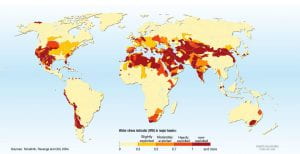 |
Papers:
- K. Lee, J. T. Ault, and H. A. Stone. Enhancement of solar still productivity using thin-film, continuous flows. Undergraduate senior thesis, Princeton University, May 2016
|
Dynamics of bubble bouncing at a liquid/liquid/gas interfacePreviously, we also studied the dynamics of an air bubble bouncing at a compound liquid/liquid/gas interface. The presence of an oil layer affects the interfacial properties, and thus modifies the entire bubble bouncing/bursting process. Specifically, we experimentally studied the bubble/fluid motions during bubble bouncing for a range of oil layer viscosities, thickness, and surface tensions. We also explored the influence of bubble size and approach velocity. Specifically, we developed reduced-order coupled mass-spring-damper models to describe bubble bouncing at a compound interface which accurately predict both the contact time and coefficient of restitution of the first bubble bounce. | 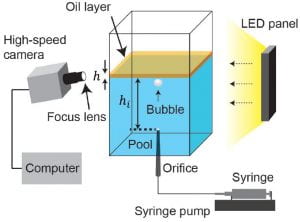 |
Papers:
- J. Feng, M. Muradoglu, H. Kim, J. T. Ault, and H. A. Stone. Dynamics of a bubble bouncing at a
liquid/liquid/gas interface. J. Fluid Mech., 807:324–352, Oct. 2016
|
Point-source imbibition into dry aqueous foamsAnother project that we explored involved using experiments, modeling, and numerical simulations to study imbibition from a point source into a dry homogeneous aqueous foam. The dynamics is driven by the capillary pressure in the liquid microchannels of the foam (Plateau borders) and is resisted by both viscous and gravitational forces. Specifically, we showed that the imbibition front tends to flatten out over time due to gravitational effects, an effect which can be quantified through the use of the Bond number, which compares the gravitational effects to the capillary pressure. We concluded that both the ratio between the oil-water and air-water interfacial tensions and the Bond number together determine the imbibition efficiency. | 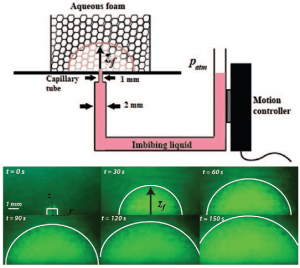 |
Papers:
- R. Mensire, J. T. Ault, E. Lorenceau, and H. A. Stone. Point-source imbibition into dry aqueous foams. EPL (Europhys. Lett.), 113(4):44002, Feb. 2016
|
Diffusive behaviors of circle-swimming nanomotorsAnother project that we have worked on involves the locomotion of catalytic nanomotors. Synthetic nanomotors are frequently being developed in an attempt to better understand and/or mimic nanoscale biomotors that are present in biological systems. Bimetallic nanomotors have been created which can swim many body lengths per second as well as pick up, manipulate, and drop off microscale cargo under the action of applied magnetic fields. We studied the short- and long-time diffusivities of gold/platinum coated bimetallic nanomotors, and compared the motors' behaviors with Brownian dynamics simulations and analytical theory. | 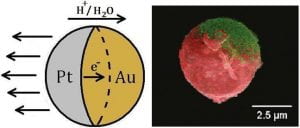 |
Papers:
- N. A. Marine, P. M. Wheat, J. T. Ault, and J. D. Posner. Diffusive behaviors of circle-swimming motors. Phys. Rev. E, 87(5), May 2013
|
Wide-field microscopy for volumetric PIVWe previously developed a high-speed axial-scanning wide-field microscopy technique for performing volumetric particle tracking velocimetry using a single-lens technique with the potential for microsecond time resolution. We utilized a fast varifocal lens in a modified wide-field microscope in order to capture both volumetric and planar information, and we demonstrated the technique by tracking particle motions in the complex, three-dimensional flow in the flow through a branching arrow-shaped junction. | 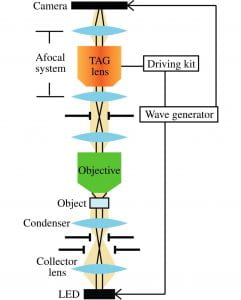 |
Papers:
- T.-H. Chen, J. T. Ault, H. A. Stone, and C. B. Arnold. High-speed axial-scanning wide-field microscopy for volumetric particle tracking velocimetry. Exp. Fluids, 58(5), Apr. 2017
|